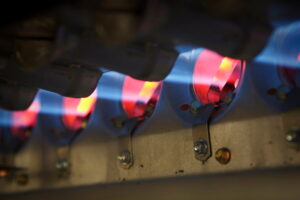 It’s cold outside this week! It’s probably safe for us to assume that you’re using your heating system on a steady basis, and you’re relying on it to keep you comfortable as well as safe.
It’s cold outside this week! It’s probably safe for us to assume that you’re using your heating system on a steady basis, and you’re relying on it to keep you comfortable as well as safe.
But did you have it professionally maintained before the heating season started? If you haven’t, the good news is that it’s not too late. Without maintenance, you can have surprise repair needs that are not only costly, but possibly harmful.
One repair to keep in mind, particularly if you have a gas furnace, is fixing or replacing a damaged heat exchanger. While no gas furnace is inherently dangerous, yours can become so if you ignore this important component.
What’s a Heat Exchanger?
This is the component that makes it possible for a heater to heat. The air that travels through your ventilation system via the blower fan has to travel over the heat exchangers first in order to pick up heat. These heat exchangers get filled up with combustion gas when the burners come on, and their metal walls become very hot.
When the blower fan of your furnace cycles on, it sends air around the exchanger, picking up heat and then traveling through the ductwork. There is no part of this process where combustion gases come into contact with the air that goes into your living space (unless the heat exchanger is damaged!).
Once the heating cycle is complete, the combustion byproducts within the heat exchanger are vented out of the furnace through a flue that releases the gas harmlessly outdoors.
Beware the Damaged Heat Exchanger
The metal walls of the heat exchanger expand and contract as the component heats up and cools down. This stress can eventually cause a crack to begin forming on the exchangers. Another potential cause of heat exchanger damage is corrosion, which can happen due to the reaction between the combustion gasses and the metal—though this is usually only a problem if the furnace isn’t properly venting.
These cracks are barely visible to the average human eye. In fact, they’re microscopic. But when the heat exchanger is hot, it expands enough that these cracks can open and let out combustion gas that can enter your indoor air. The most harmful of these gasses is carbon monoxide (CO).
“Do I Have a Damaged Heat Exchanger?”
Fortunately, there are a couple of things you can watch out for when it comes to the state of your heat exchanger. A major warning sign, for instance, is a clicking sound coming from the furnace shortly after the blower shuts off. This can be the heat exchanger cooling off and contracting, but it won’t make that noise if it’s totally intact.
Another sign of a problem is visible corrosion. If you’re seeing corrosion on the outside of your furnace, then there’s a good chance that there is corrosion on the inside too, and it could be affecting the heat exchangers.
One thing to keep in mind about all of this is that damaged heat exchangers are much more common in aging furnaces—that is, furnaces that are 10–15 years old. This doesn’t mean you shouldn’t have your furnace maintained each year if it’s newer. In fact, routine maintenance will help you avoid this problem altogether!
Comfort Flow Heating is your resource for expert furnace repair in Eugene, OR. Contact us today!
